I should also give a mention to fell running, another regular fixture at the Cumbrian county show. Fell running is the sport of running off road, over upland country where the gradient climbed is a significant component of the difficulty. The name arises from the origins of the sport on the fells of northern England, especially those in the Lake District.

Fell runners compete in the senior guides race at the Ennerdale and Kinniside Show
When and where fell racing began is unknown, but as early as 1850 it was taking place at Grasmere. The participants ran up a hillside to a flag on the summit of the fell, then returned as fast as they could to the starting point where the winner was greeted by a band playing ‘See the conquering hero.’
Anyone with the stamina to stay the course can participate. Traditionally farmers, farm workers and shepherds were involved. Today there are countless races during the summer with men, women and children (most shows have junior races for children as young as 10) running the fells around the county.
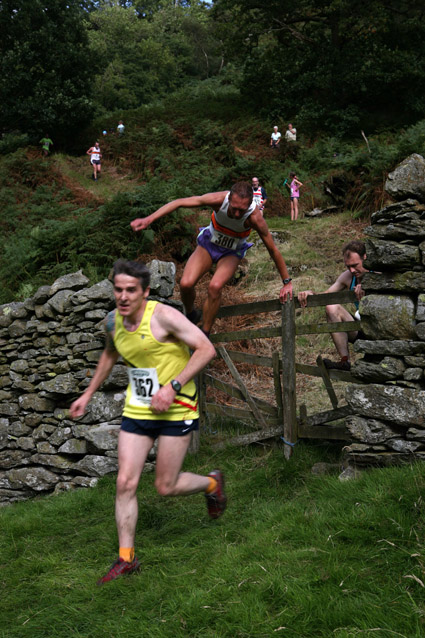
The English Hill Championship Race at Grasmere Sports & Show
I witnessed several races at the Grasmere Sports & Show last weekend. While it took me nearly 35 minutes to climb to the summit of the race route (admitedly I was carrying the 5×4 and a rather heavy tripod), the winning runner in the English Hill Championship Race, Rob Jebb, finished the race in a staggering 12 minutes and 38 seconds – only 17 seconds outside the record!
Such are the passions surrounding the sport, the fell running legend Joss Naylor recently urged the organisers of the Olympics to include the sport in the 2012 London Olympics. Joss, 72, made his comments after he joined Sir Chris Bonnington in climbing to the top of Scafell Pike on Sunday to raise the Olympic flag.Â
To find out more about the sport, read Richard Askwith’s critically acclaimed book Feet in the Clouds: A Tale of Fell-running and Obsession.Â
Â
Posted in EVENTS & PASTIMES | 1 Comment »
One of the highlights of a county show in Cumbria is the traditional local sport of Cumberland & Westmorland Wrestling. C&WW has an ancient history, it is thought the Vikings brought the sport to England, however its glory days occurred in the eighteenth and nineteenth centuries.
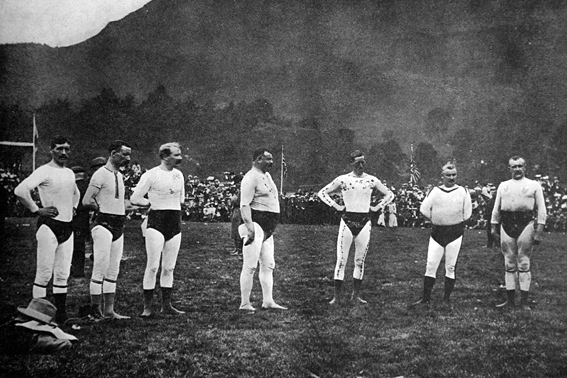
Wrestlers at the Grasmere Lakeland Sports & Show, 1903
In the mid-nineteenth century, wrestling had acquired a very wide popularity, attracting both competitors and spectators from inside and outside Cumbrian boundaries. In 1851 at Flan How, Robert Atkinson of Sleagill, Westmorland, met William Jackson of Kinneyside, Cumberland, for the Championship of England. The contest, for a purse of £300, attracted one of the largest crowds ever to witness the sport with an estimated 10,000 spectators. Atkinson won, by three fans to one.
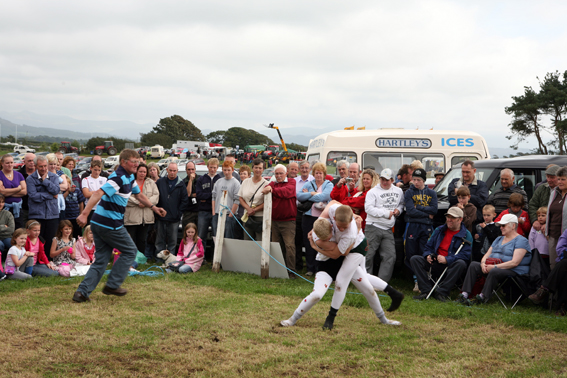
Two junior wrestlers in traditional costume compete at this year’s Gosforth Show
To begin a match, the wrestlers must “tekk hod” – linking their fingers together behind the back of their opponent. This can take quite a while! The contest is ‘best of three falls’. If the hand hold is broken, that also constitutes a fall. In the 18th and 19th centuries, men competed for substantial cash prizes and local status. In these centuries, match fixing was a problem – it was known as ‘barneying’. Wrestling always takes place on grass.
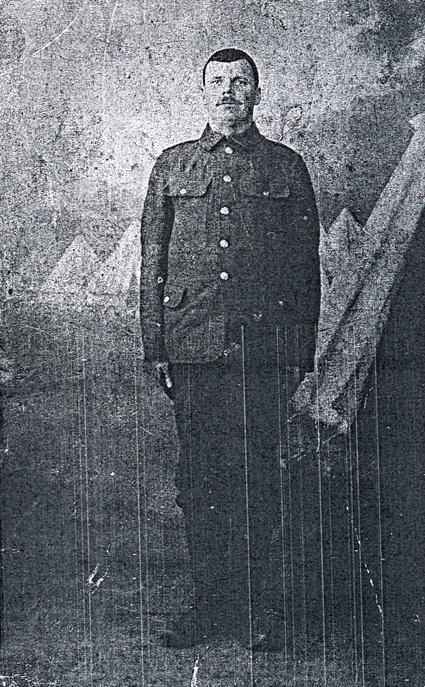
18649 Private Henry WalshÂ
While researching the sport I discovered that one of my distant relatives, Henry Walsh, (my Mum’s cousins grandfather) was a champion Cumberland wrestler winning between 1910-12. Born in Cleator Moor, Walsh was brought up in the town of Frizington. His wrestling career came to an abrupt end with the onset of the First World War. He enlisted with the Cumberland 3rd Border Regiment and was one of many soldiers gassed in battle. Sent back to the UK to recuperate, he died soon after aged just 27.
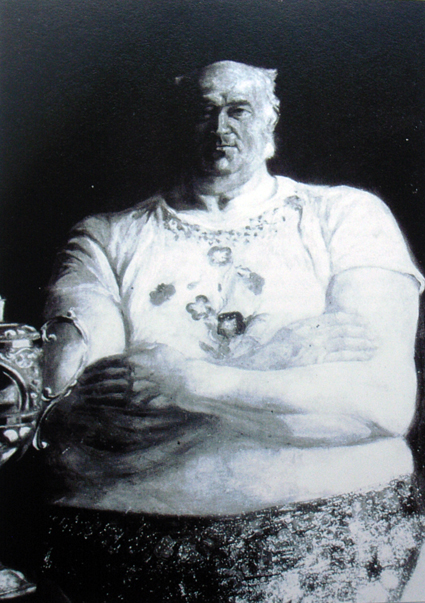
George Steadman
Of all the heroic figures celebrated in the annals of wrestling, none can equal George Steadman of Asby, near Appleby. In 1900 at the age of fifty-four, he decided to quite the ring having won the Heavyweight Championship at Grasmere on no fewer than seventeen occasions.
Â
Posted in EVENTS & PASTIMES | 6 Comments »
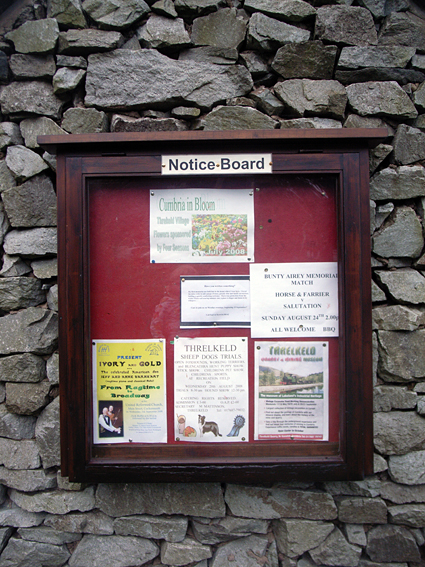
I’ve found the community noticeboard – often found outside shops, churches and village halls, as well as in the local newspaper – a valuable resource, both in terms of finding out about events happening during my stay but also as a gauge of local interest.
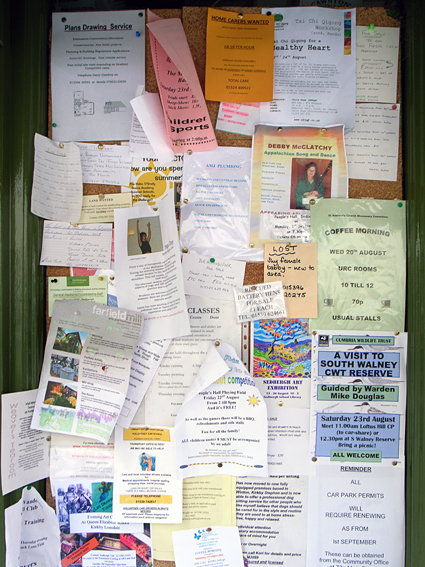
Â
For instance, here are a few events listed in the Whitby Gazette, August 12th –
- St Hilda’s Church garden party will be held in the grounds of the Old Recotry in Sneaton by kind permission of Ian Buckle, today at 2.30pm. There will be the usual stalls, tombola and competitions and farmhouse teas will be served int eh village hall.
- The Goathland Walking Group meets at the shops on Thursday at 10am.
- Sleights Horticultural and Industrial Society will hold its 127th annual show on Saturday on Sleights sportsfield, Lowdale Lane, 1.30-4pm. Admission adults £1.50, children 50p, concessions £1.
- Whitby Young Farmers’ Club sponsored walk in aid of Pancreatic Cancer UK – Gallon walk from Mallyan Spout, Goathland is on Friday, for sponsor forms and details contact Kathryn on 810202.
- The Dalesmen are holding their annual garden party on August Bank Holiday, Monday 25 August, 10am-4pm, at Waites House, Goathland, the home of the choir’s president, Audrey Smith. Admission is free but cream teas are available for purchase throughout the day. There will be a cake, plant and bric-a-brac stalls and a tombola. The Dalesmen Singers will be doing two singing spots during the day at noon and 2pm.
- Robin Hood’s Bay Bowling Club Tuesday afternoon whilst drives taken place at 2pm in the bowling club. New players welcome.
Â
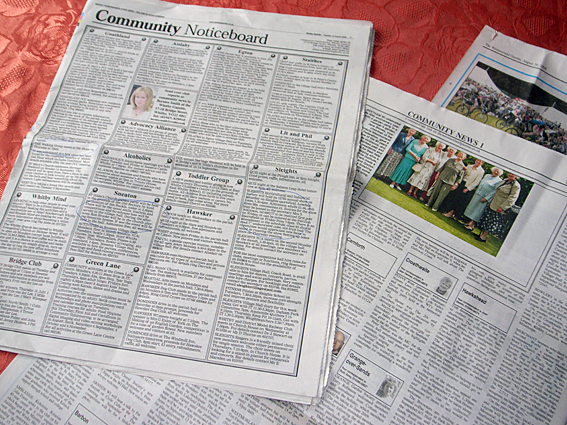
Â
And in a round-up of last week’s events The Westmorland Gazette, August 29th, reports –
- Despite the recent poor weather, the Barbon and Middleton Flower Show had more entrants than usual. A new class for oven-baked cakes by men only was well supported, and for the first time a visitors’ choice was held and was won by Janet Greenwood with a knitted Herdwick wool throw.
- Beetham WI celebrated its 90th anniversary year with a garden party in a member’s garden. Jane Binney, vice-chairman of the Cumbria-Westmorland Federation, gave a resume of the 90 years of its existence, and thanked past and present presidents and members for their help in keeping alive a worthwhile institute.
- Kendal Fellwalkers explored the fells near Wasdale during their B walk. From the roadside near Santon Bridge, they climbed to the little-frequented summit of Irton Fell. There were good views of Wastwater as they made their way along the grassy ridge above the Wastewater screes.
- Geoff Harrison won the Bowling Leasgill Trophy in a closely fought contest. Gordon Coleclough was runner up.
- The latest STEPS walk was through Trowbarrow Quarry to Hazelslack Tower and back via Haweswater. Those take part saw dragonflies, butterflies and hardly any people.
Â
Posted in EVENTS & PASTIMES, RESEARCH | Comments Off on COMMUNITY NOTICEBOARDS
There’s an interesting article in today’s Daily Telegraph by Jack Watkins where he explores the enduring appeal of the Shell travel guides, which published in the first half of the past century.
The Shell Guides were aimed at a new breed of car-driving metropolitan tourists. They were for those who sought guides that were neither too serious nor too shallow and who took pleasure in the ordinary and peculiar culture of small town Britain. In the three decades after the Second World War the Shell Guides provided a “surreptitiously subversive synthesis of the British countryside,” says Dr David Heathcote, curator of an exhibition on the books at the Museum of Domestic Design & Architecture (MODA) in Hertfordshire.
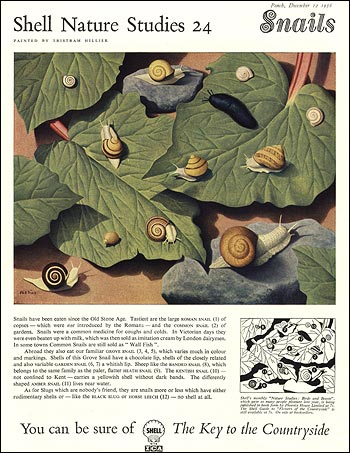
As Watkins notes, “it was the Shell Guides, with their sharp writing and atmospheric black and white photos and pictures, that elevated the medium to an art form.” The first one, on Cornwall and penned by Sir John Betjeman, was published in 1934. It was quickly followed by volumes for Devon, Dorset and Derbyshire, and the series grew, undergoing various revisions, into the 1980s.

 “These slender tomes, long edited by Betjeman, were at their best when focusing on small towns and villages”, says Heathcote.

 “Metropolitan cities were mostly ignored and instead they plunged enthusiastically into the local, the particular and – above all – the peculiar. Today we’ve got the likes of the Rough Guides, which are only interested in places they regard as ‘cool’ and thus dismiss swathes of Britain as not worth visiting.”
I’m particularly interested in this assertion by Watkins: “The assumption that tourism is merely a glorified consumer experience is bad enough when applied to our oldest towns. It turns them into ‘anywherevilles’, with shopping and eating as the main end purpose. But, in a subtler way, it has even happened to rural parts of Britain. The plethora of national parks and conservation areas does protect fragile aspects of the natural or built heritage, but by default has led to superficial branding by marketing bodies. It has dangerously eroded an appreciation of the locally endearing, or what Betjeman might have called the ‘superficially mundane’.”
For similar discussions on the blog regarding branding and the heritage industry see my previous posts here and here.
The Shell Guides: Surrealism, Modernism, Tourism is at MODA until November 2 (020 8411 5244). The exhibition explores the creative forces that created the Shell County Guides. It considers their widespread cultural influence on our shared understanding of Britain and British-ness.
Posted in REPRESENTATION, RESEARCH | Comments Off on SUPERFICIALLY MUNDANE VS ANYWHEREVILLES
On Monday night, Panorama looked at the issue of Britishness in a program called True Brits. Unfortunately I missed it, but here is the background information on the program, taken from the Panorama website.
“In June this year, Liam Byrne, home office minister for borders and immigration, mooted the idea that the August bank holiday be made Britishness Day – a day of national celebration of our country along the lines of America’s 4 July holiday. His suggestion was instantly dubbed a “blunder” by the Scottish National Party, which was quick to point out that the August bank holiday is at the start of the month in Scotland, while in England and Wales it is at the end.
But even if this scheduling glitch could be overcome, huge questions still remain about how Britishness should be defined. So, on the very day which Mr Byrne suggested should be Britishness Day, Panorama: True Brits tries to answer the question what exactly is Britishness? And just as importantly, why is the government suddenly talking about it? However, as Panorama reporter Vivian White soon finds, virtually everyone seems to have a different definition of what Britishness is – that is if they are able to come up with one at all.
‘Loss of freedoms’
Prime Minister Gordon Brown – who revealed this month that he is preparing to write a book on what it means to be British – has said that it is all about shared values:Â “We share the same values about liberty, about democracy, about the need for social cohesion and for people to work together co-operatively,” Mr Brown said.
People tell Panorama what they think symbolises Britishness. But fashion designer Vivienne Westwood, who in the 1970s used satirical images of the Queen when creating her iconoclastic punk styles, tells the programme that those values and freedoms are disappearing fast, and that the government is leading the way in dismantling them.
British National Party (BNP) chairman Nick Griffin says being British is about being of British stock, in other words white. But in recent decades the ethnic makeup of Britain has been transformed by mass migration.
Governments both past and present called on people to celebrate their differences and called it “multiculturalism”. In July 2005 projecting that rainbow world identity helped us to win the prize of hosting the 2012 Olympics.
But the very next day a few British citizens made it clear their loyalties lay elsewhere by mounting the 7 July suicide bomb attacks on the London transport system, forcing Britishness and a debate about what it means be British top of the agenda.
Radical view
However, as True Brits reports, when the government poses the question “are you really one of us?” the answer is often not a simple Yes or No. Mozzam Begg, a British-born radical Muslim, is best known for having spent two years in Guantanamo Bay, only to be finally released without charge. When being held by at the US detention facility his American guards were in no doubt as to his Britishness – referring to him by the name Great Britain and even making sure that he was kept informed when the Queen Mother died. He however, is not so sure, telling the programme that he does not “think anybody knows actually what Britishness is including the people who want to tell us what they think Britishness is”.
And north Yorkshire schoolboy Cameron agrees. He believes the government are asking us to define Britishness for them because they don’t know what it is and need our help.
When asked whether “being British is more important to my sense of identify than my family’s country of origin” 43% of young people from ethnic minorities disagreed as opposed to 29% of their white counterparts. In other words young people from ethnic minorities are more likely to plump for their family’s country of origin as their marker of identity than young white people.
Rite of passage
And they are not alone – as the programme reports, in 1974 when forced to pick only one national identity, 31% of people in Scotland said that they were British, but by 2006 this figure had fallen to 14%. In 2005 the government introduced new procedures for foreigners wanting to become British citizens whereby applicants have to read a book called Life in the UK and sit a 45-minute test on society, history and culture before taking part in a ceremony marking their change of nationality.
The programme asks if this kind of education about Britishness and ceremony should be extended to young people turning 18, to mark their graduation to full status as a True Brit. One of the teenagers Vivian speaks to says that the government should not be asking what is Britishness is at all because a British citizen will be different everywhere you look.
Perhaps this in itself is something to celebrate. But, as the programme reports, even if we could agree on what to celebrate we are unlikely to agree on how to – after all isn’t all of that Union Jack waving stuff frankly rather un-British?”
Â
Here are some viewers comments about the program.
Â
Posted in ENGLISHNESS | Comments Off on TRUE BRITS – PANORAMA
After nearly four months on the road we’ve now arrived in Cleator Moor, the small Cumbrian town where my mum grew up and where many of her extended family still reside. It’s been a place of pilgrimage for our family almost every summer since she left for London in her early twenties.
In his thoroughly researched book Cleator and Cleator Moor, Past and Present, which first published in 1916, Caesar Caine, Vicar of Cleator, wrote: “The ancient parish of Cleator lies midway between St. Bees on the Cumberland coast, and Ennerdale Lake which is embosomed amid the most westerly summits of the Cumbrian hills. From either of these beautiful, and deservedly popular resorts, Cleator can be reached by the pedestrian in about an hour. Nor is Cleator to be despised by the lover of nature and the sight-seer, in spite of its mines and manufactures of to-day. The place has many beauty spots, and boasts of an overshadowing mountain, rich in wild life….without its mines, manufactures, and rows of houses, [Cleator] has become most familiar to me, and I have learned to love it more, in some respects, as it was, rather than it is.â€
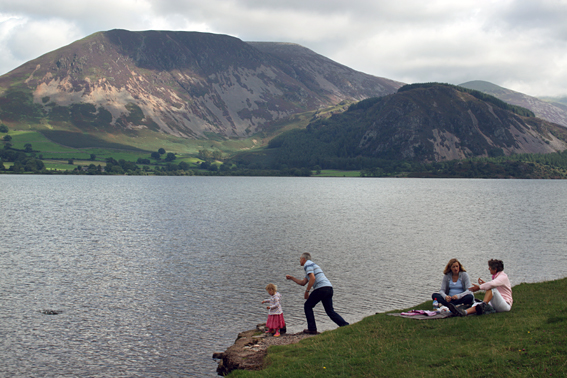
Picnic on Lake Ennerdale
Joined by my mum and dad, we’ll be spending the next few days visiting – and photographing – some of the holiday spots around Cleator Moor, resurrecting old family traditions such as walking along St Bees Head, having a bbq on the shores of Crummock Water, attending some County shows, throwing skimmers into Lake Ennerdale and climbing some mountains (such as Scafell Pike- below).
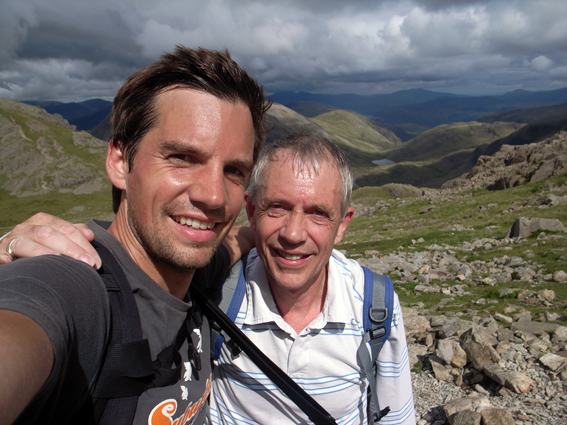
Dad and I climbing Scafell Pike from Wasdale Head
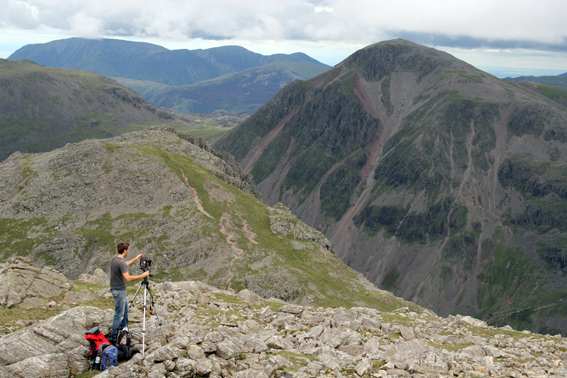
Photographing climbers on Scafell Pike
Â
Posted in PLACES | Comments Off on FAMILY TRADITIONS
I couldn’t resist posting up another picture from the nudist weekend at the Tan Hill Inn. This was the scene that greeted my daughter from the motorhome!
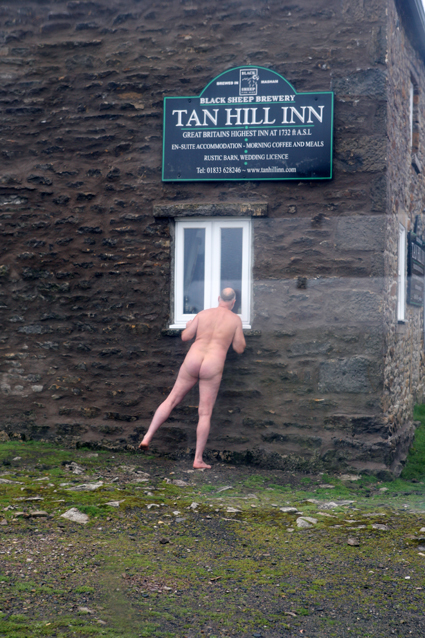
Â
Posted in POSTCARDS | Comments Off on DADDY, THAT MAN’S NAKED!
Continuing my weekly dispatch in The Times, week 13 was taken in Tan Hill, Yorkshire Dales.
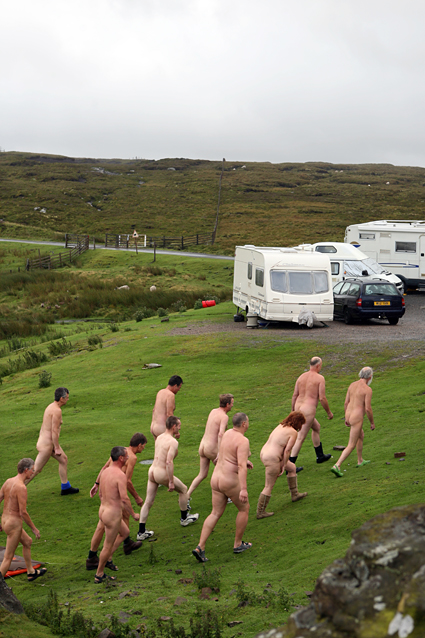
Tan Hill, Swaledale, North Yorkshire, 17th August 2008
Members of the British Naturism Society attend a pub weekend at the Tan Hill Inn, the highest pub in Britain. Despite the torrential rain, members took advantage of the fact that nudity was permitted in a private area of the pub as well as the camping area. The British Naturism Society has over 16,000 members and naturism is growing in popularity all the time.
This week we’ll be in Cumbria.
Â
Posted in POSTCARDS | Comments Off on POSTCARD IN THE TIMES – WEEK 13
It’s Bank Holiday Monday and I should be climbing Helvellyn along with the hordes of holidaymakers and ramblers who are in the region to make the ascent of this popular Lakeland mountain. Instead I’m camped out in a tea house in Keswick trying to stay dry, with hordes of holidaymakers and ramblers!
Whilst tucking into a steak pie and cursing the English summer that never was, I came across today’s Weatherwatch in The Guardian. It points out that the holiday month of August has always been prone to extremes, with high rainfall chief among them and quotes from the weather diary of Sir John Wittewronge of Rothamsted, Hertfordshire. In his August 1685 records Sir John notes that his apricots and peaches by reason of the “unseasonable wett weather ripened very ill†and a good number of the peaches “rotted and fel off.†The year “was a long and wett unreasonable harvest as I ever remember.†His entry for today, August 25, reads: “A cloudy day with frequent showers of rain, in the evening thunder and lightening and rain to some purpose from five to past seven continually and after by intervals til 9.â€
Thinking about it, the unpredictability of the British climate has informed much of the character of English art: stormy northern skies conjured an entirely different atmosphere and type of landscape than the bright, blue clarity of southern Europe. The moisture which steams out of Turner’s canvases as well, or that makes Constable’s so uncannily clear and fresh.
I’ll leave you with this quote from Charles II, who had been brought up in France, but regarded the English climate as more attractive, saying “he lik’d…that Country best, which might be enjoy’d the most Hours of the Day, and the most Days in the Year, which he was sure to be done in England more than in any country whatsoever.â€
Posted in TRIP LOGISTICS | Comments Off on DIARY OF SIR JOHN WITTEWRONGE
August’s unseasonably wet weather has played havoc with Cumbria’s county shows after the region saw almost an entire month’s worth of rainfall within the first 12 days. In the past week alone over half a dozen county shows have been cancelled due to flooded fields, among them the Keswick Agricultural Show, Lunesdale Show, Hawkshead Agricultural Show and Rydal Sheepdog Trials and Hound Show. The latter was cancelled for only the third time in its 106-year history.
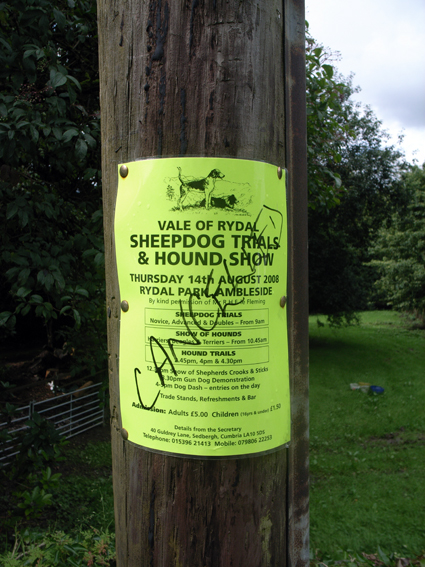
Â
The county show has been a summer fixture in most Cumbrian towns and villages for over a century and has always been of vital importance to the local community. Many of the shows have managed to remain genuinely traditional Lakeland affairs. So I was particularly disappointed to hear that the Patterdale Dog Day had been cancelled this week due to a waterlogged field. The show has kept to its original format and fiercely resisted the lure of commercialization.
This is in stark contrast to many of the national agricultural shows such as The Royal Show which I attended earlier this year, where I counted an astonishing 48 corporate sponsors including HSBC, Trinity Private Wealth Management, RAC, Muller, Renotherm foam insulation, McDonalds and all the major supermarket chains who were trumpeting their support of British farmers. (Such as M&S, one of the major ‘partners’ of the show, who had a large hospitality tent for their clients).
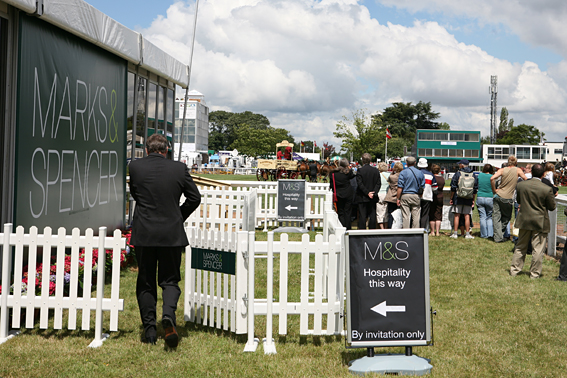
Â
I’m planning to attend the Grasmere Sports And Show this weekend so decided to phone the organizers to check that it would still be going ahead. The reply I got from the director of the show was definitive: “Young man, Grasmere Sports has been running since 1852 and never been cancelled. It went ahead during both World Wars so it’s going to take a lot more than a few drops of rain to stop us this year!â€
One show that did beat the rain this week was held at Gosforth (it only went ahead following an emergency committee meeting on Monday). It was a very understated affair with the traditional mix of horse and pony displays, Cumberland and Westmoreland wrestling, a local produce tent and various competitions. Peter Wright’s honey won the best exhibit in the section, while Gosforth WI took first prize in their category with their exhibit ‘A leisurely lunch’. In the horticulture tent, Mark Hewertson, who won in the gladioli, pansies and fuschia categories, was named the Best in Show. My favourite competition judging took place in the poultry tent where Robert Brown, from Uldale, took the top prize with his clay/wheaten.Â
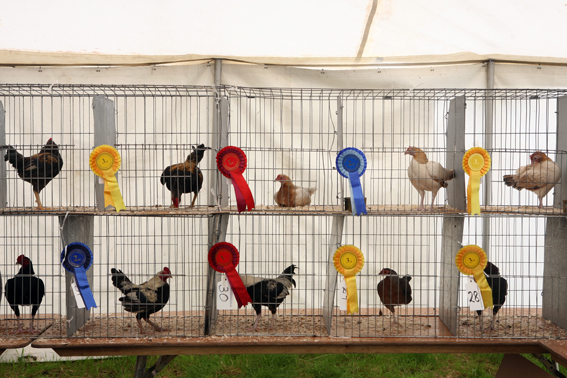
Â
The Ennerdale and Kinniside Show also went ahead despite driving rain. It took place at Kirkland Leaps showfield. The event started life in 1895 as a village flower show and “Scholars Picnic†with the sole purpose of raising money to send the children of Ennerdale and Kinniside school on a day trip.
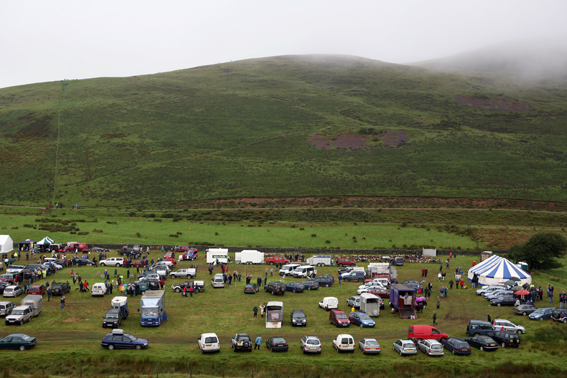
Â
From 1900 sheep were introduced, then sports and other livestock until it became known as T’laal Royal. Typical in its links with the valley, village and farming communities Ennerdale Show has also had a special relationship with the people of industrial West Cumbria.Â
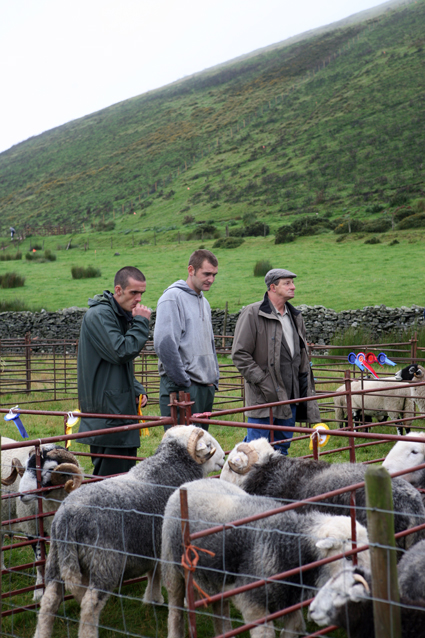
Â
Posted in EVENTS & PASTIMES, PLACES | 1 Comment »





















